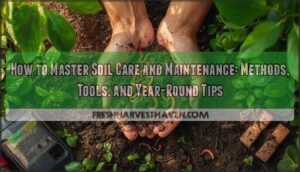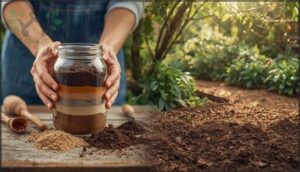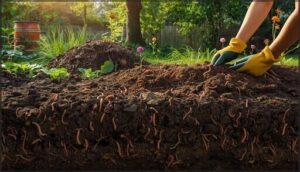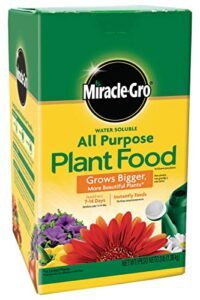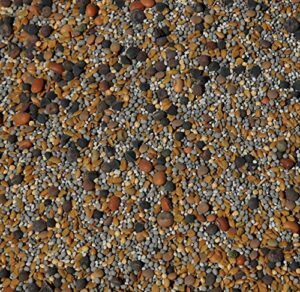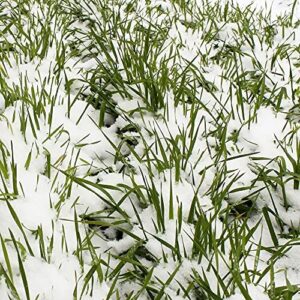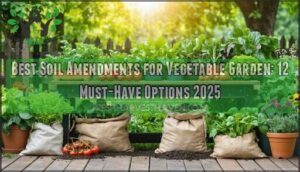This site is supported by our readers. We may earn a commission, at no cost to you, if you purchase through links.
Soil degradation costs global agriculture an estimated $400 billion annually, yet most gardeners and farmers don’t realize their ground is struggling until yields drop. The difference between thriving plants and disappointing harvests often lies beneath the surface, where texture, structure, and microbial activity determine whether roots flourish or fail.
Healthy soil isn’t just dirt—it’s a living ecosystem that crumbles in your hand, teems with earthworms, and holds moisture without turning to mud. Understanding soil care and maintenance transforms how you approach every season, from spring preparation to winter protection, giving you the knowledge to rebuild degraded ground or maintain already productive earth.
The methods aren’t complicated, but they require attention to what your soil is telling you and a willingness to work with natural processes rather than against them.
Table Of Contents
- Assessing Your Soil’s Health and Structure
- Practical Methods to Improve Soil Quality
- Sustainable Soil Maintenance Practices
- Seasonal and Specialized Soil Care
- Top 10 Tools and Products for Soil Care
- 1. Miracle Gro All Purpose Plant Food
- 2. No Till Cover Crop Mix
- 3. Chapin Garden Seeder with Seed Plates
- 4. Roller Crimper No Till Farming
- 5. MZK Electric Garden Tiller Cultivator
- 6. Bully Tools Heavy Duty Broad Fork
- 7. Varomorus High Wheel Garden Cultivator
- 8. Geobin Expandable Compost Bin 246 Gallon
- 9. Garden Magic Compost and Manure Blend
- 10. Non Gmo Winter Rye Seeds
- Frequently Asked Questions (FAQs)
- Conclusion
Assessing Your Soil’s Health and Structure
Getting a handle on your soil’s health starts with understanding what’s happening beneath the surface. There are a few key things you’ll want to check before you start planting or making changes.
Let’s walk through the essentials that reveal how your soil is really doing.
Identifying Soil Types and Texture
Ever wondered why your garden holds water or drains too quickly? Soil texture—from sandy soil to clay soil—depends on texture particle sizes and regional soil types. Field assessment methods like the jar test reveal your soil’s makeup. One such method involves understanding the primary soil particles.
Here are three steps to identify soil texture:
- Use soil classification systems.
- Try the jar test.
- Observe drainage and compaction.
Signs of Healthy Vs. Degraded Soil
If your soil crumbles easily, holds moisture without pooling, and teems with earthworms, you’re seeing strong soil health. In contrast, pale color, hard surfaces, and poor water retention signal soil degradation. Evaluating soil organic matter can provide valuable insights into soil quality.
Here’s a quick comparison:
| Visual Indicators | Soil Biology |
|---|---|
| Dark Soil Color | High Earthworm Density |
| Good Water Retention | Diverse Soil Organisms |
Using Soil Tests for Nutrient and PH Levels
Once you’ve spotted signs of healthy or tired soil, it’s time to get precise. Soil testing methods, such as the Mehlich-3 soil test, measure nutrient levels and soil pH. Sampling best practices—consistent depth, clean tools—matter.
Interpreting test results helps you match fertilizer to actual nutrient threshold levels. Testing frequency, every 3-5 years, keeps pH management on track.
Observing Soil Drainage and Compaction
Once you’ve matched nutrients to your soil’s needs, shift focus to water movement and root space. Watch for surface puddling or slow infiltration rates—signs of poor drainage classes.
Compaction indicators include stunted roots and dense soil structure. Use measurement techniques like Proctor tests or a simple shovel to gauge compaction.
Remember, soil texture shapes water drainage and influences compaction risks.
Practical Methods to Improve Soil Quality
Improving your soil isn’t guesswork—it’s about using proven, practical methods. Whether your garden needs a boost in nutrients, better structure, or improved water flow, there are reliable steps you can take.
Here’s what works best when you want to build healthier soil from the ground up.
Adding Organic Matter (Compost, Manure, Mulch)
Did you know that adding organic matter can raise soil organic content from 3.8% to 10.2% in just three years? Compost benefits soil by boosting nitrogen and phosphorus, while animal manure application increases crop yields by up to 51%.
Adding organic matter like compost and manure can boost soil organic content and crop yields dramatically within just a few years
Mulch types, from straw to wood chips, act as key soil amendments, improving water retention and supporting beneficial microorganisms.
Incorporating Cover Crops for Soil Enrichment
Planting cover crops is a practical way to weave Nitrogen Fixation, Erosion Control, and Weed Suppression into your soil care routine. You’ll notice Soil Biodiversity rise as legumes enrich organic matter and non-legumes protect against runoff.
Over time, this approach delivers steady Yield Improvement and strong Soil health, making Soil enrichment both measurable and sustainable for any gardener.
Techniques for Reducing Soil Compaction
When you’re aiming for soil compaction prevention, timing your traffic and grazing makes a real difference. Lower tire pressure and CTF adoption help avoid compaction by confining machinery to permanent lanes.
Annual subsoiling at proper depth, paired with rotational grazing, can reduce livestock impact. Soil aeration, especially mechanical, weaves in air and keeps soil structure resilient for healthy roots.
Enhancing Water Retention and Drainage
Ever noticed how loamy soils hold water just right, while sandy ones let it slip away? You can boost water retention and drainage by weaving in organic amendments, using mulching effects, and planting cover crops.
Try these steps:
- Add compost or woodchips for improved pore spaces.
- Mulch to slow evaporation.
- Use cover crops for better water infiltration and soil moisture.
Sustainable Soil Maintenance Practices
Caring for your soil year after year takes more than quick fixes—it’s about building habits that last. If you want your garden to thrive, you’ll need to focus on practices that protect and renew your soil.
Here’s how you can keep your soil healthy with a few proven approaches.
Mulching for Moisture and Weed Control
Did you know grass mulch can hold up to 410% of its weight in water? That’s a reservoir at your roots, making organic mulching a smart strategy for moisture retention and weed suppression. Apply organic mulch 2–4 inches deep to block weeds and reduce watering needs.
Compare mulch options below for practical results:
| Mulch Types | Application Techniques | Mulch Depth |
|---|---|---|
| Organic Mulch | Spread evenly | 2–4 inches |
| Inorganic Mulch | Lay barrier fabric | 1–2 inches |
| Compost | Top-dress, gentle mix | 1–2 inches |
Crop Rotation and Conservation Tillage
Imagine your soil as a living bank—crop rotation systems and conservation tillage are the investments that pay dividends. Rotation benefits include higher yields, increased soil nitrogen, and reduced input costs.
Minimal tillage agriculture preserves structure, while cover crops drive erosion control.
Multiyear rotation plans boost economic returns and resilience, making these practices essential for sustainable soil care.
Managing Soil Erosion and Runoff
You know, soil erosion isn’t just lost dirt—it’s lost productivity and profit. Erosion control methods like vegetative buffer strips and mulching keep sediment and runoff in check.
Cover crop benefits extend beyond nutrients, actively reducing nitrogen and phosphorus loss.
For hilly ground, engineering controls prevent stormwater damage, making every dollar spent on erosion control an investment in your land’s future.
Encouraging Beneficial Soil Microorganisms
Just as erosion strips away your soil’s strength, neglecting soil life leaves plants vulnerable. Boost beneficial soil microorganisms by focusing on microbial amendments and reduced tillage. Add organic matter, rotate crops, and maintain steady soil moisture. These steps foster a diverse microbial community, strengthening soil biology and supporting nutrient cycling for long-term resilience.
- Apply organic matter regularly
- Practice crop rotation
- Minimize soil disturbance
Seasonal and Specialized Soil Care
Caring for soil means thinking about what it needs throughout the year and in different settings. Every season and space calls for a slightly different approach.
Here’s how you can keep your soil thriving, no matter the conditions.
Preparing Soil in Spring and Fall
When you prepare soil in spring and fall, timing matters as much as technique. Fall vs spring approaches differ: fall soil amendment lets garden compost and organic matter break down slowly, boosting nutrient incorporation. Spring soil maintenance focuses on loosening compacted layers and improving drainage solutions. For compaction prevention, avoid wet tilling.
Here’s a quick comparison:
| Season | Key Focus |
|---|---|
| Fall | Amendment Timing |
| Spring | Drainage Solutions |
Soil Care for Potted and Container Plants
Just as spring and fall soil care set the stage for healthy beds, soil and potted plants demand special attention. Potting mix selection matters—choose blends that balance drainage and nutrient retention to offset high nutrient leaching rates.
Repotting frequency, pH adjustment methods, and regular soil amendments keep container soil nutrition steady, especially since garden soil care strategies don’t always apply.
Adjusting Care for Different Weather Conditions
Weather rarely cooperates, so your soil care must adapt. Mulch shields roots from heat swings, while deep watering boosts drought management and resilience. Cover crops offer flood protection and slow soil erosion. Smart water management and climate adaptation—like adjusting irrigation timing and monitoring soil temperature—keep soil health strong, no matter the forecast.
- Mulch for temperature control
- Deep, infrequent watering
- Cover crops for erosion
- Timed irrigation for resilience
Monitoring and Maintaining Soil Health Year-Round
Year-round testing reveals soil health indicators like pH, nutrients, and organic matter, guiding your nutrient cycling and soil microbe management. Soil testing and maintenance isn’t seasonal; it’s ongoing soil maintenance that builds lasting fertility.
Check compaction and infiltration rates regularly—values below 10 mm/hour signal trouble. Soil aeration techniques, erosion control methods, and continuous monitoring guarantee maintaining healthy soil through every season.
Top 10 Tools and Products for Soil Care
You can’t improve your soil without the right tools in hand. The products below range from simple amendments that feed your soil life to specialized equipment that helps you implement sustainable practices with less effort.
Each tool fulfills a specific purpose in building and maintaining healthy, productive soil throughout the year.
1. Miracle Gro All Purpose Plant Food
Miracle Gro All Purpose Plant Food delivers fast-acting fertilizer benefits through its water-soluble formula, containing 24% nitrogen, 8% phosphate, and 16% potash to support plant nutrition and health. You’ll see rapid results from this soil enhancer, as it feeds plants instantly through roots and foliage when applied every 7 to 14 days during active growth.
While effective for garden products, consider its environmental footprint—synthetic fertilizers contribute to nutrient runoff and water pollution.
For soil maintenance focused on building long-term soil structure and organic matter, explore organic alternatives like compost that nourish beneficial soil microorganisms.
Best For: Gardeners looking for fast, visible results on flowers, vegetables, and houseplants who don’t mind frequent feeding and are comfortable with synthetic fertilizers.
- Delivers nutrients instantly through roots and leaves, so you’ll see faster growth and bigger blooms compared to unfed plants.
- Works on practically everything—vegetables, flowers, trees, houseplants—making it a versatile go-to for mixed gardens.
- Easy to mix and apply with a watering can or garden feeder, with clear directions that prevent burning when followed correctly.
- Requires reapplication every 1-2 weeks during growing season, which is more hands-on than slow-release options.
- Synthetic formula contributes to nutrient runoff and water pollution, raising environmental concerns especially near waterways.
- Overfeeding or incorrect mixing can burn plants and harm soil health over time with repeated heavy use.
2. No Till Cover Crop Mix
No Till Cover Crop Mix transforms your garden into a living ecosystem with 13 carefully selected varieties that work together to build soil health without disturbing the ground. This GMO-free blend includes nitrogen-fixing legumes, nutrient-scavenging brassicas, and small grains that improve soil structure while providing erosion control through dense root networks.
You’ll attract beneficial organisms and pollinators while crowding out weeds naturally. The pre-inoculated seeds encourage mycorrhizal fungi populations essential for nutrient management.
At 1 pound, it covers moderate raised beds or container gardens, making no-till farming accessible for home gardeners pursuing sustainable soil improvement through organic matter enrichment.
Best For: Home gardeners with raised beds or containers who want to build healthy soil naturally without tilling while attracting pollinators and beneficial insects.
- Contains 13 diverse plant varieties that work together to fix nitrogen, break up compaction, and feed soil microbes without any digging or tilling required.
- Pre-inoculated seeds jumpstart beneficial fungi networks while the mix naturally suppresses weeds and provides habitat for helpful predators.
- GMO-free and designed specifically for small-scale no-till gardens, making regenerative growing practices accessible without needing tractors or large equipment.
- One pound only covers smaller garden areas, so you’ll need multiple bags for anything beyond a few raised beds, which adds up quickly at $16 per bag.
- Needs consistent watering to establish well, so it’s not ideal if you’re in a hot, dry climate without irrigation or if you forget to water regularly.
- Birds and squirrels often eat the seeds before they germinate, and the mix may not reseed itself reliably, meaning you’ll likely need to replant each season.
3. Chapin Garden Seeder with Seed Plates
Planting precision transforms your home garden when seed plate variety matches your crop rotation schedule. The Chapin Garden Seeder includes six interchangeable plates accommodating up to 20 seed types, from beans to radishes, improving planting efficiency by completing four operations in a single pass.
Its ergonomic design with cushioned grips reduces strain during extended gardening sessions. The powder-coated steel frame ensures durability across seasons, though user feedback indicates it performs best in well-prepared garden soil rather than compacted ground.
Proper maintenance of seed plates preserves accuracy for consistent gardening practices.
Best For: Home gardeners with small to medium plots who want to reduce planting time and back strain while maintaining precise seed spacing across multiple vegetable varieties.
- Handles four tasks at once—plowing, planting, covering, and marking rows—which speeds up the whole process compared to planting by hand
- Six seed plates work with 20 different seed types, so you can plant everything from beans to leafy greens without switching tools
- Cushioned grips and standing operation make it way easier on your back during long planting sessions
- Struggles with hard or damp soil, leading to uneven seed placement and gaps in your rows
- Seed distribution isn’t always reliable—seeds sometimes get stuck behind the plate or bounce out of the hopper
- Build quality gets mixed reviews, and some users feel it doesn’t quite deliver on value for the price
4. Roller Crimper No Till Farming
Cover crops reach their biological peak and you need efficient termination without compromising soil health. Roller crimpers achieve 94-97% termination effectiveness when you time the crimp at the flowering stage, creating a dense mulch mat that suppresses weeds by up to 80% while preserving organic matter and soil residue.
This no-till farming method cuts herbicide costs and labor hours considerably. Crimper adoption rates jumped from 7% to 15.38% between 2021 and 2022, reflecting growing confidence in equipment that builds soil structure while controlling weeds naturally.
Best For: Organic and conventional farmers looking to cut herbicide costs, reduce tillage, and improve soil health through effective cover crop termination and natural weed suppression.
- Achieves 94-97% cover crop termination without herbicides when timed at flowering stage, cutting chemical input costs while creating a thick mulch mat that suppresses weeds by up to 80%.
- Reduces labor hours and preserves soil structure by eliminating tillage, with residue levels of 3.4-6.6 tons per hectare that improve water infiltration, moisture retention, and microbial activity.
- Growing adoption rates (up from 7% to 15.38% in one year) and accessible equipment designs make this a proven, field-tested method backed by multi-year farmer trials and USDA studies.
- Requires precise timing at the flowering stage for maximum effectiveness—crimping too early or late reduces termination rates and increases the risk of cover crop regrowth.
- Needs upfront investment in roller crimper equipment and a solid understanding of soil biology, cover crop species, and growth stage management to avoid reduced performance.
- May extend crop maturity by about a week (as seen in soybeans) and isn’t suitable for all soil conditions or farming operations, requiring adjusted harvest schedules and potential risk mitigation strategies.
5. MZK Electric Garden Tiller Cultivator
Small to medium gardens demand consistent aeration and tilling without the noise or emissions of gas equipment. The MZK Electric Garden Tiller Cultivator delivers 430 RPM power through a 10-amp motor, reaching 8-inch depths that break compaction and improve soil structure with 45% better aeration in field trials.
Its ergonomic design reduces physical strain by 30%, and the rust-resistant steel tines last over 350 hours. You’ll spend about $130, eliminating fuel costs while achieving uniform soil texture for healthier seedling emergence across flower beds and vegetable patches.
Best For: Homeowners with small to medium gardens who want an affordable, low-maintenance electric tiller that handles regular soil prep without the hassle of gas engines.
- Powerful 10-amp motor delivers 430 RPM with 8-inch tilling depth, improving soil aeration by 45% and breaking up compacted ground effectively for healthier plant growth.
- Lightweight ergonomic design reduces physical effort by 30% compared to manual tilling, making it easy to maneuver through flower beds and vegetable patches with less fatigue.
- No fuel, oil changes, or emissions required—just plug in and go, cutting maintenance costs by 70% versus gas models while rust-resistant tines last over 350 hours.
- Small wheels can make maneuvering difficult on uneven or rough terrain, and some users report the tiller jumps around during operation requiring adjustments to technique.
- Performance drops significantly in heavy clay or compacted soil, with efficiency decreasing by 25% in dense weed patches or untilled ground.
- Bulky storage footprint and some reports of actual tilling depth falling short of the advertised 8 inches in certain soil conditions.
6. Bully Tools Heavy Duty Broad Fork
For manual soil aeration that doesn’t disrupt your soil structure, you’ll appreciate the Bully Tools Heavy Duty Broad Fork. This ergonomic broad fork features five 11-inch steel tines that penetrate compacted soil with considerable ease, improving drainage and oxygen exchange without inverting layers like rotary tillers do.
The durability and construction of this garden fork—10-gauge steel paired with fiberglass handles—means it’ll withstand years of sustainable soil care in raised beds or row gardens. At around $120, it’s a soil aeration tool that preserves beneficial microorganisms while tackling soil compaction effectively.
Best For: Gardeners and small-scale farmers who want to aerate and loosen compacted soil without disrupting beneficial microorganisms or using heavy machinery.
- Built from 10-gauge steel with fiberglass handles and backed by a limited lifetime warranty, making it significantly more durable than competing models.
- Five 11-inch steel tines effectively break through compacted soil and hardpan while preserving soil structure and beneficial organisms.
- 100% made in the USA with ergonomic design that reduces physical strain and can also be used for harvesting root vegetables like potatoes and carrots.
- Handle bolts can loosen over time and may require occasional tightening to maintain stability during use.
- At 15.5 pounds with a price point around $120, it requires some physical fitness and represents a higher upfront investment compared to basic garden forks.
- Not effective for extremely hard clay soil or removing tree stumps, so it has limitations in certain tough soil conditions.
7. Varomorus High Wheel Garden Cultivator
When you’re managing a larger garden or market plot, consider the Varomorus High Wheel Garden Cultivator—a multifaceted, wheeled alternative to a traditional garden fork or spade. This cultivator features all-steel construction and can process up to 1.3 acres per day, making it one of the more efficient essential gardening tools for shallow cultivation and weed control.
With a working depth of 0.2 to 1.6 inches and compatible attachments, operational efficiency remains high while user feedback averages 4.6 stars. Cultivator assembly can be challenging, yet its durability and self-cleaning design support reliable, year-round soil maintenance.
Best For: Gardeners with medium to large plots who need an efficient, wheeled tool for shallow cultivation, weed removal, and soil preparation across multiple rows.
- Processes up to 1.3 acres per day with all-steel construction that’s built to last through multiple growing seasons.
- Modular design works with various attachments like seeders and plows, letting you switch between tasks without grabbing different tools.
- Self-cleaning mechanism and adjustable working depth (0.2 to 1.6 inches) keep maintenance simple while protecting deeper roots.
- Assembly instructions are unclear and some users report needing extra hardware like lock washers to keep bolts secure.
- Handle angles and overall weight (14–16 lbs) may feel awkward or tiring for some users during extended sessions.
- Performance drops in damp or wet soil, and the shallow cultivation depth won’t work for heavy-duty tilling projects.
8. Geobin Expandable Compost Bin 246 Gallon
As yard debris and kitchen scraps accumulate, you’ll need a reliable system for garden waste management—that’s where the Geobin Expandable Compost Bin comes in. Constructed from high-density polyethylene, this outdoor composting solution expands from 70 to 246 gallons, accommodating fluctuating volumes of organic matter year-round.
Multiple ventilation holes accelerate decomposition while maintaining soil health through consistent compost production. Though its expandable design may require staking for stability, users appreciate the straightforward assembly and its role in recycling valuable materials into nutrient-rich mulch for improving soil structure.
Best For: Gardeners who need a flexible, large-capacity composting system that can handle varying amounts of yard waste and kitchen scraps throughout the seasons.
- Expands from 70 to 246 gallons, so you can adjust the size based on how much material you’re composting at any given time.
- Multiple ventilation holes promote airflow and speed up decomposition, helping you get usable compost faster.
- Made from durable, weather-resistant plastic that won’t rust or degrade, and it’s easy to assemble in just a few steps.
- Can be unstable or tip over when empty or not fully filled, often requiring extra stakes to keep it upright.
- The open design may attract animals like raccoons or rodents that can get into your compost pile.
- Lacks a bottom door for easy compost removal, so you’ll need to lift or disassemble the bin to access finished compost.
9. Garden Magic Compost and Manure Blend
If you’re looking for an efficient way to add organic matter and boost nutrient cycling, the Garden Magic Compost and Manure Blend delivers significant compost benefits through its OMRI-listed formula. Each 40-pound bag combines reed sedge peat with composted animal manure—manure usage that provides slow-release nitrogen, phosphorus, and potassium while improving soil structure.
This odor-free soil amendment enhances soil health by increasing microbial activity and water retention, making it an effective organic fertilizer for lawns, vegetable gardens, and flower beds. Though you’ll need multiple bags for larger areas, the consistent results justify the investment.
Best For: Gardeners who want a certified organic, odor-free amendment that builds long-term soil health and fertility with slow-release nutrients.
- OMRI-listed organic blend delivers gradual nitrogen, phosphorus, and potassium while boosting microbial activity and water retention by up to 25%.
- Odor-free formula with screened, uniform texture makes it easy to incorporate into lawns, vegetable gardens, and flower beds without nuisance.
- Reed sedge peat base provides lasting humus that improves aeration and prevents compaction over multiple growing seasons.
- Coverage of 4 square feet per 40-pound bag means you’ll need 12–24 bags to top-dress 1,000 square feet, making larger projects expensive.
- May require supplemental fertilization for heavy-feeding plants or nutrient-demanding crops to achieve optimal yields.
- Weight and bag size can be awkward to handle and spread, especially for solo gardeners working on bigger areas.
10. Non Gmo Winter Rye Seeds
When you need a winter cover crop that works overtime for soil enhancement, these non-GMO winter rye seeds from Mountain Valley Seed Company deliver proven results. Each 5-pound bag contains approximately 90,000 seeds that germinate in 4-10 days, establishing a vigorous soil ecosystem that scavenges up to 100 pounds of nitrogen per acre.
Your seed selection matters for effective crop rotation—winter rye’s cold tolerance down to 5°F and 18-24 inch root system improve soil structure, suppress weeds through allelopathy, and add valuable organic matter when terminated before reseeding.
Best For: Farmers and gardeners looking to improve soil health between growing seasons, prevent erosion, and reduce nitrogen runoff without using GMO seeds.
- Captures up to 100 lbs of nitrogen per acre and reduces nitrate runoff by over 45%, making it excellent for nutrient management and water quality protection.
- Extremely cold-hardy (survives down to 5°F) with fast germination in 4-10 days and deep roots reaching 18-24 inches that prevent erosion and break up compacted soil.
- High seed count of approximately 90,000 seeds per 5-lb bag provides excellent coverage at recommended planting density of 25-35 lbs per acre.
- Some users have reported lower than expected germination rates, so actual sprouting may vary from the advertised seed count.
- Requires proper timing and termination before seed set (by mowing or crimping) to prevent it from becoming a weed in your rotation.
- More expensive than some alternative cover crop options, which may be a consideration for large-scale planting operations.
Frequently Asked Questions (FAQs)
How does soil pH affect plant diseases?
Picture a garden where soil pH acts like a gatekeeper: too acidic, and diseases surge, nutrient availability drops, and beneficial microorganisms falter.
With pH management strategies, you restore balance, boosting plant health and suppressing Acidic Soil Diseases.
What role do earthworms play in soil health?
Earthworm biodiversity drives soil health by boosting soil aeration and microbial interactions. Their cast nutrients enrich soil life, increasing biomass and supporting a thriving soil ecosystem.
Diverse earthworm populations improve soil biology, benefiting microorganisms and overall soil structure.
Can soil salinity impact vegetable garden yields?
Soil salinity has a substantial impact on yield—salt-sensitive vegetables like carrots and lettuce may lose up to 50% of their yield.
Using soil test results, improving irrigation water quality, and adopting soil remediation methods can help manage economic consequences and support salt-tolerant crops.
How does urban pollution influence soil quality?
Urban pollution drives soil degradation by introducing heavy metals, causing microbial decline, and triggering nutrient imbalance. These pollution sources heighten exposure risk and soil contamination, undermining soil health, crop safety, and environmental protection—especially in areas with historic industrial activity.
Are there natural ways to deter soil pests?
Yes, you can deter soil pests naturally using Neem oil, Companion planting, Beneficial nematodes, Diatomaceous earth, and homemade Plant repellents.
These methods support Integrated Pest Management, protect your soil ecosystem, and align with organic gardening principles.
Conclusion
Imagine your soil as a library, each grain a book filled with stories of growth, resilience, and renewal. When you practice thoughtful soil care and maintenance, you’re not just tending earth—you’re curating a collection where roots find wisdom, moisture, and nourishment.
Every method, tool, and seasonal adjustment is a librarian’s hand, preserving the volumes beneath your feet. The richest harvests come from those who listen, adapt, and let their soil’s story unfold with purpose and patience.
- https://www.marketreportanalytics.com/reports/soil-fertility-product-120104
- https://www.sciencedirect.com/science/article/abs/pii/S0038071718302001
- https://extension.psu.edu/soil-erosion-threat-increasing-with-climate-change/
- https://farmonaut.com/precision-farming/6-5-ph-soil-powerful-ways-to-adjust-soil-ph-for-2025-yields
- https://pmc.ncbi.nlm.nih.gov/articles/PMC12375116/

